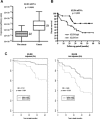High kallikrein-related peptidase 6 in non-small cell lung cancer cells: an indicator of tumour proliferation and poor prognosis
- PMID: 19426157
- PMCID: PMC4516548
- DOI: 10.1111/j.1582-4934.2009.00763.x
High kallikrein-related peptidase 6 in non-small cell lung cancer cells: an indicator of tumour proliferation and poor prognosis
Abstract
The human kallikrein-related peptidases (KLK) are serine proteases whose concentrations are often abnormal in common human malignancies and contribute to neoplastic progression through multifaceted roles. However, little attention has been paid to their synthesis and involvement in the development and dissemination of lung cancer, the leading cause of cancer mortality worldwide. We have analysed the production of KLK6 in normal lung and tumour tissues from patients with non-small cell lung cancer (NSCLC). KLK6 immunoreactivity was restricted to epithelial cells of the normal bronchi, but most of the cancer samples were moderately or highly immunoreactive, regardless of the histological subtype. In contrast, little or no KLK6 was detected in NSCLC cells. We have developed NSCLC lines expressing wild-type KLK6 in order to investigate the role of KLK6 in lung cancer biology, and analysed its impact on proliferation. Ectopic KLK6 dramatically enhanced NSCLC cell growth and KLK6-producing NSCLC cells had accelerated cell cycles, between the G1 and S phases. This was accompanied by a marked increase in cyclin E and decrease in p21. KLK6 production was also associated with enhanced synthesis of c-Myc, which is known to promote cell-cycle progression. Finally, examination of specimens from patients with NSCLC revealed that KLK6 mRNA is overexpressed in tumour tissue, and high KLK6 concentrations were associated with lower survival rates. We conclude that a high concentration of KLK6 is an indicator of tumour proliferation and an independent predictive factor in NSCLC.
Figures




References
-
- Borgoño CA, Diamandis EP. The emerging roles of human tissue kallikreins in cancer. Nat Rev Cancer. 2004;4:876–90. - PubMed
-
- Hutchinson S, Luo LY, Yousef GM, et al. Purification of human kallikrein 6 from biological fluids and identification of its complex with alpha(1)-antichymotrypsin. Clin Chem. 2003;49:746–51. - PubMed
-
- Petraki CD, Karavana VN, Skoufogiannis PT, et al. The spectrum of human kallikrein 6 (zyme/protease M/neurosin) expression in human tissues as assessed by immunohistochemistry. J Histochem Cytochem. 2001;49:1431–41. - PubMed
-
- Petraki CD, Papanastasiou PA, Karavana VN, et al. Cellular distribution of human tissue kallikreins: immunohistochemical localization. Biol Chem. 2006;387:653–63. - PubMed
-
- Shaw JL, Diamandis EP. Distribution of 15 human kallikreins in tissues and biological fluids. Clin Chem. 2007;53:1423–32. - PubMed
Publication types
MeSH terms
Substances
LinkOut - more resources
Full Text Sources
Other Literature Sources
Medical
Molecular Biology Databases

